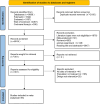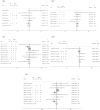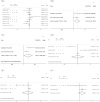Risk factors for bloodstream infection in COVID-19 patients in intensive care units: a systematic review and meta-analysis
- PMID: 39754037
- PMCID: PMC11697680
- DOI: 10.1186/s12879-024-10420-1
Risk factors for bloodstream infection in COVID-19 patients in intensive care units: a systematic review and meta-analysis
Abstract
Background: Risk factors for bloodstream infection in patients with COVID-19 in the intensive care unit (ICU) remain unclear. The purpose of this systematic review was to study the risk factors for BSI in patients admitted to ICUs for COVID-19.
Methods: A systematic search was performed on PubMed, EMBASE, Cochrane Library, and Web of Science up to July 2024. Data were reported as combined odds ratio (OR) for categorical variables and weighted mean difference (WMD) for continuous variables.
Results: 6914 studies were retrieved, of which 55 were included in the meta-analysis. Men (OR = 1.28, 95% CI: 1.10-1.50, P = 0.006), high SAPS II score (WMD = 6.43, 95% CI: 0.23-12.63, P = 0.042), diabetes (OR = 1.34, 95% CI: 1.04-1.73, P = 0.022), tracheal intubation (OR = 8.68, 95% CI: 4.68-16.08, P < 0.001), mechanical ventilation (OR = 22.00, 95% CI: 3.77-128.328, P < 0.001), ECMO (OR = 2.70, 95% CI: 1.17-6.26, P = 0.020), central venous cannulation (OR = 9.33, 95% CI: 3.06-28.43, P < 0.001), prolonged ICU stay (WMD = 10.37, 95% CI: 9.29-11.44, P < 0.001), methylprednisolone use (OR = 2.24, 95% CI: 1.24-4.04, P = 0.008), and the combination of methylprednisolone and Tocilizumab (OR = 4.54, 95% CI: 1.09-18.88, P = 0.037) were risk factors for ICU-BSI in COVID-19 patients.
Conclusion: We identified 10 risk factors for ICU-BSI in COVID-19 patients. In future studies, these factors can be combined to establish a more comprehensive and accurate prediction model for ICU-BSI in COVID-19 patients. Targeted measures can be taken earlier to control BSI.
Keywords: Bloodstream infection; COVID-19; ICU; Meta-analysis.
© 2025. The Author(s).
Conflict of interest statement
Declarations. Ethics approval and consent to participate: Not applicable. Consent for publication: Not applicable. Competing interests: The authors declare no competing interests.
Figures






Similar articles
-
Bloodstream infections in critically ill patients with COVID-19.Eur J Clin Invest. 2020 Oct;50(10):e13319. doi: 10.1111/eci.13319. Epub 2020 Aug 11. Eur J Clin Invest. 2020. PMID: 32535894 Free PMC article.
-
Examination of Risk Factors Affecting the Development of BSI and Mortality in Critically Ill COVID-19 Patients Hospitalized in Intensive Care Unit (ICU): A Single-Center Retrospective Study.J Intensive Care Med. 2025 May;40(5):547-555. doi: 10.1177/08850666241305347. Epub 2024 Dec 20. J Intensive Care Med. 2025. PMID: 39704100
-
Incidence, Risk Factors, and Prognosis of Bloodstream Infections in COVID-19 Patients in Intensive Care: A Single-Center Observational Study.J Intensive Care Med. 2022 Oct;37(10):1353-1362. doi: 10.1177/08850666221103495. Epub 2022 May 23. J Intensive Care Med. 2022. PMID: 35607286 Free PMC article.
-
Global Impact of Coronavirus Disease 2019 Infection Requiring Admission to the ICU: A Systematic Review and Meta-analysis.Chest. 2021 Feb;159(2):524-536. doi: 10.1016/j.chest.2020.10.014. Epub 2020 Oct 15. Chest. 2021. PMID: 33069725 Free PMC article.
-
Clinical course and outcomes of critically ill patients with COVID-19 infection: a systematic review.Clin Microbiol Infect. 2021 Jan;27(1):47-54. doi: 10.1016/j.cmi.2020.10.017. Epub 2020 Oct 23. Clin Microbiol Infect. 2021. PMID: 33190794 Free PMC article.
References
-
- Adrie C, Garrouste-Orgeas M, Ibn Essaied W, Schwebel C, Darmon M, Mourvillier B, Ruckly S, Dumenil AS, Kallel H, Argaud L, et al. Attributable mortality of ICU-acquired bloodstream infections: impact of the source, causative micro-organism, resistance profile and antimicrobial therapy. J Infect. 2017;74(2):131–41. - PubMed
-
- Llitjos J-F, Bredin S, Lascarrou J-B, Soumagne T, Cojocaru M, Leclerc M, Lepetit A, Gouhier A, Charpentier J, Piton G, et al. Increased susceptibility to intensive care unit-acquired pneumonia in severe COVID-19 patients: a multicentre retrospective cohort study. Ann Intensive Care. 2021;11(1):20. - PMC - PubMed
Publication types
MeSH terms
LinkOut - more resources
Full Text Sources
Medical

